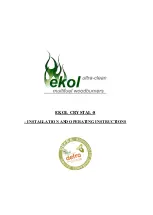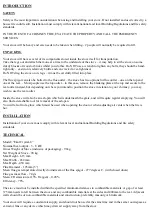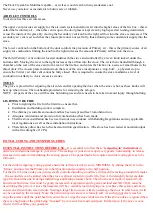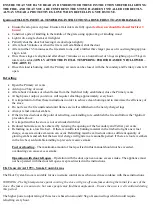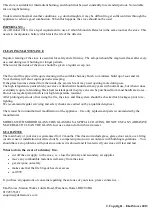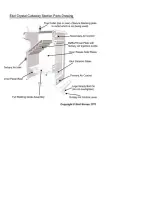
The Ekol Crystal-8 is Multifuel capable – as well as wood it can burn any smokeless coal.
Never use your stove as incinerator to burn waste or rubbish.
AIR INLET CONTROLS
Your stove has three air inlet areas-
The upper vent provides air supply for the air-wash system and allows air into the higher areas of the fire box – this is
called the Secondary air – when this vent is open, the door glass is kept clean by high speed air rushing downwards
across the inside of the glass. By moving the Secondary vent knob to the right, airflow into the stove is increased. The
secondary air vent is set such that the closure plate does not seal fully, thus allowing some constant air supply into the
stove.
The lower vent knob on the bottom of the door controls the provision of Primary air – this is the primary source of air
supply for combustion. Sliding the knob to the right increases the amount of Primary airflow into the stove.
The third (Tertiary) vent control is located underneath the stove and controlled by a lever/ knob tucked under the
bottom shelf. Moving the lever to the right increases the airflow into the stove. The air is then channelled through a
chamber on the rear of the stove and to the rear of the firebox, and enters the firebox via a series of small holes in the
throat plate. The closure plate mechanism on the rear of the stove incorporates a ‘stop-bolt’ – a physical stop to
ensure the Tertiary air inlet vent cannot be fully closed. This is required to ensure the stove maintains a level of
combustion not likely to create excessive smoke.
TOOLS
The glove is provided for adjusting the air inlets and for opening the door when the stove is hot, as these knobs will
heat up when in use. The tool handle provided is for removing the ash-pan.
NOTE – all parts of the stove will become hot during use and care needs to be taken to avoid injury through burning.
LIGHTING THE FIRE
Prior to lighting the fire for the first time, ensure that-
Installation and building work is complete.
The chimney is suitable and sound and has been swept and free from obstruction.
Adequate ventilation and provision for combustion air has been made.
That the stove installation has been carried out in accordance with Building Regulations and any applicable
local regulations as well as these installation instructions.
That chimney draw has been checked and within specification. (The stove has been tested at nominal output
with a flue draught of 12 Pa)
INITIAL CURING AND TEMPERING FIRES
ESSENTIAL INSTRUCTIONS BEFORE USE –
It is essential to follow these
‘tempering-in’
instructions
in
order to avoid serious damage to your stove. The castings of your stove require very gentle ‘normalising’ to release
stresses in the metal formed during the casting process. The paint finish also requires an initial curing process to be
followed: -
For the initial tempering/ curing period, ensure the tertiary air inlet is set to MINIMUM, by sliding the lever to the
‘Minus’ position. Set the Primary air to half position and secondary air to half position.
For the first 2 burns on day one just use small controlled kindling wood fires with each fire lasting around 40 minutes
– the second fire can be started when the stove is almost cooled down after the first. A third slightly hotter medium
type fire should then be lit using smallish logs and lasting around 1 hour. Then for the next week or around 15-20
hours total burn time, fires must be gently increased in temperature and log size and load and NO COAL must be
used during this period. A stove thermometer will be a valuable tool in helping you to achieve this safely and also to
ensure an efficient burn rate in future. Starting a large fire too soon is likely to damage the stove in which case it will
not be covered by the warranty. Note: the paint on any new stove is relatively soft. As such do not clean, wash or
wipe the surface until the paint has fully cured. Never wipe the stove whilst warm. If the above advice is ignored then
there is a high risk of the paint being “shocked” by excessive heat and could peel. Furthermore, if the stove is over-
fired it will invalidate your guarantee.
Содержание CRYSTAL-8
Страница 1: ...EKOL CRYSTAL 8 INSTALLATION AND OPERATING INSTRUCTIONS...
Страница 7: ......

